Common Welding Fixing Issues and How to Address Them Properly
Welding fixings frequently encounter an array of problems that can jeopardize the stability of the end product. Typical problems consist of poor penetration, porosity, and misalignment, among others. Each problem provides distinct obstacles that need specific strategies for resolution. Recognizing these issues is important for welders intending to enhance their abilities and outcomes. This conversation will discover these usual welding repair work concerns and effective methods to address them.
Inadequate Infiltration
Insufficient penetration happens when the weld metal fails to fully fuse with the base material, causing weak joints and potential architectural failures. This problem typically comes from inadequate warm input, wrong electrode angle, or incorrect welding speed. Welders might run into inadequate penetration as a result of a miscalculation of the required specifications for a details material density or type. In addition, contamination on the base material's surface can impede efficient bonding, worsening the issue. To attend to poor penetration, welders should ensure ideal settings on their devices and keep a tidy job surface area. Regular evaluation of welds is recommended to recognize any shortages early, permitting timely modifications and the prevention of jeopardized architectural integrity in bonded assemblies.
Porosity
Porosity is an usual flaw in bonded joints that manifests as little gas bubbles trapped within the weld steel. This defect can compromise the stability of the weld, resulting in lowered stamina and prospective failing under stress. Belgrade. Porosity typically emerges from contamination, dampness, or inappropriate welding techniques, which enable gases to run away right into the molten weld pool. To deal with porosity, welders must ensure proper surface prep work, maintain a clean workplace, and use appropriate welding criteria. Additionally, selecting the right filler product and shielding gas can alleviate gas entrapment. Routine evaluation and testing of welds can help determine porosity early, assuring prompt restorative actions are taken, consequently maintaining the high quality and reliability of the bonded framework
Imbalance
Imbalance in welding can occur from different factors, including inappropriate setup and thermal development. Comprehending the source is important for reliable resolution. A number of modification techniques are offered to realign components and guarantee architectural stability.
Reasons of Imbalance
Welding misalignment usually stems from a range of underlying problems that can jeopardize structural honesty. One primary cause is improper fit-up of elements prior to welding, which can lead to gaps and unequal surface areas. Variations in thermal expansion throughout the welding procedure can additionally result in distortion, particularly if the materials being signed up with have different coefficients of development. Additionally, inadequate fixturing and securing might stop working to hold parts safely in area, leading to motion during welding. Improperly kept tools, consisting of welding makers and tools, might present variances in the weld bead, more adding to imbalance. Operator error, stemming from insufficient training or experience, can likewise play a substantial function in producing misaligned welds.

Improvement Strategies Readily Available
Attending to imbalance efficiently requires a combination of rehabilitative techniques tailored to the particular issues available. One typical technique is using fixtures or jigs to hold parts in the appropriate setting throughout welding, guaranteeing constant placement. In addition, preheating the products can help in reducing distortion and improve fit-up. For substantial imbalance, mechanical adjustment methods, such as utilizing hydraulic jacks or clamps, can be utilized to fix the placement before welding. Post-weld warm therapy may additionally be required to relieve stress and anxieties brought on by misalignment. Careful evaluation and change throughout the configuration phase can protect against misalignment issues from coming to be significant troubles, advertising a smoother welding process and improving overall structural stability.
Distortion
Distortion is a common challenge in welding that can emerge from various variables, consisting of uneven cooling and heating. Recognizing the root causes of distortion is essential for executing effective prevention strategies. Resolving this problem not only boosts architectural honesty yet likewise improves the overall high quality of the weld.
Reasons for Distortion
When based on the intense warm of welding, products typically undergo adjustments that can result in distortion. This phenomenon mostly develops from thermal development and contraction throughout the welding process. As the weld location warms up, the material increases; upon cooling, it acquires, which can develop internal anxieties. On top of that, unequal heating throughout a work surface can aggravate these stresses, leading to warping or bending. The kind of product also plays a substantial duty; metals with varying thermal conductivity and coefficients of growth might react differently, causing unpredictable distortions. Inadequate joint design and insufficient fixturing can contribute to imbalance throughout welding, raising the likelihood of distortion. Comprehending these causes is crucial for reliable welding repair and prevention approaches.
Avoidance Techniques
Efficient avoidance techniques for distortion during welding emphasis on managing warm input and making certain proper joint layout. Maintaining a consistent warm input aids to decrease thermal expansion and contraction, which can bring about distortion. Using methods such as preheating the work surface can additionally lower the temperature slope, promoting consistent heating. Furthermore, choosing ideal joint layouts, such as T-joints or lap joints, can enhance security and lower anxiety focus. Executing proper fixturing to secure the work surfaces in location better help in keeping placement during the welding process. Staggered welding sequences can disperse warm more evenly, preventing local distortion. By using these strategies, welders can considerably reduce the likelihood of distortion and improve the general quality of their welds.
Breaking
Breaking is a typical concern experienced in welding repair services, commonly arising from numerous elements such as inappropriate air conditioning rates, material selection, or poor joint prep work. The occurrence of cracks can substantially endanger the stability of the weld, resulting in potential failures during procedure. To address this concern, welders need to first evaluate the origin, guaranteeing that materials are suitable and properly chosen for the particular application. Additionally, controlling the air conditioning price throughout the welding procedure is vital; quick cooling can induce stress and anxiety and result in breaking. Correct joint style and prep work additionally add to decreasing the risk. Applying these strategies can enhance weld quality and toughness, eventually reducing the chance of cracking in ended up weldments.

Incomplete Blend
A substantial problem in welding fixings is insufficient blend, which takes place when the weld metal does not adequately bond with the base product or previous weld passes - Belgrade Welding. This defect can cause weaknesses in the joint, potentially endangering the honesty of the welded structure. Elements adding to insufficient blend include not enough warmth input, inappropriate welding method, and contamination of the surfaces being signed up with. To resolve this problem properly, welders need to ensure correct pre-weld cleaning and surface prep work, in addition to adjust their welding parameters to attain sufficient infiltration and blend. Normal examination throughout the welding procedure can additionally help determine insufficient fusion early, enabling timely restorative procedures to improve the general high quality of the weld
Overheating
While welding repair work can boost architectural stability, overheating provides a substantial challenge that can lead to material deterioration. Extreme warm throughout welding can alter the mechanical homes of steels, leading to reduced toughness, raised brittleness, and warping. This sensation is specifically vital in high-stress applications where structural dependability is vital. Identifying overheating can include visual evaluations for staining or distortion, along with checking temperature during the welding procedure. To minimize the dangers connected with getting too hot, welders must employ appropriate strategies, such as managing heat input, changing traveling rate, and utilizing suitable click filler materials. Furthermore, applying pre- and post-weld warmth therapies can aid restore product homes and improve the total quality of the repair, guaranteeing long-term efficiency and security.
Regularly Asked Questions
What Are the Usual Indications of a Welding Flaw?

Exactly How Can I Evaluate My Welds for High quality?
To evaluate welds for quality, one can use aesthetic inspections, ultrasonic screening, and radiographic techniques. Each strategy ensures structural stability, determines flaws, and confirms adherence to specified criteria, ultimately enhancing the integrity of the welded joints.
What Security Safety Measures Should I Take While Welding?
When welding, one need to focus on security by wearing ideal individual safety devices, guaranteeing proper ventilation, protecting combustible materials away, preserving a clean office, and recognizing surroundings to stop injuries and accidents.
Can I Fix a Weld Without Renovating the Entire Joint?
Repairing a weld without remodeling the whole joint is feasible, relying on the damages (Montana Mobile Welding and Repair Belgrade Fabrication). Methods such as welding magnesium grinding, adding filler product, or using a welding process can effectively resolve details defects while protecting the surrounding structure
What Devices Are Essential for Efficient Welding Services?
Necessary devices for efficient welding repair services include a welding equipment, cable brush, grinder, protective gear, clamps, and filler products. Each device plays a vital role in guaranteeing top quality and safety during the repair service procedure. Porosity commonly arises from contamination, moisture, or inappropriate welding techniques, which allow gases to run away into the molten weld pool. Improperly conserved tools, consisting of welding machines and tools, might introduce variances in the weld bead, more contributing to imbalance. When subjected to the extreme heat of welding, materials frequently undertake modifications that can lead to distortion. Breaking is an usual concern run into in welding repair work, often resulting from various aspects such as improper cooling prices, product selection, or poor joint preparation. A considerable Read Full Report issue in welding repair services is insufficient blend, which occurs when the weld metal does not appropriately bond with the base product or previous weld passes.